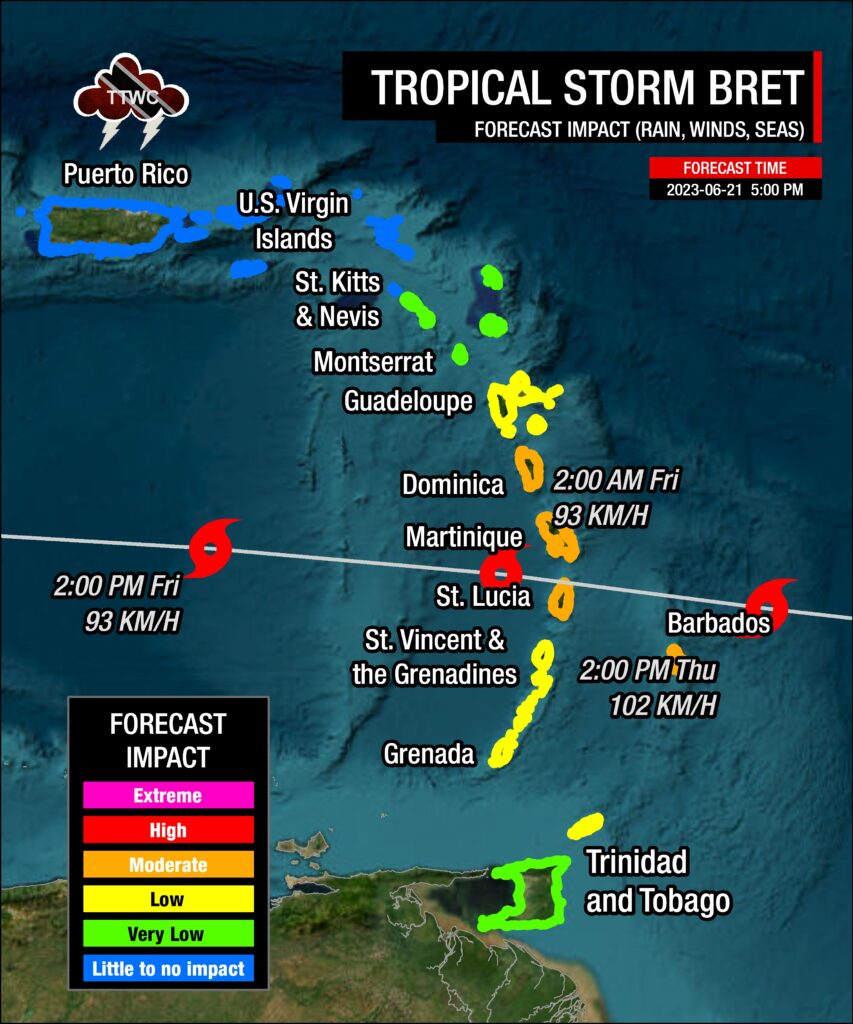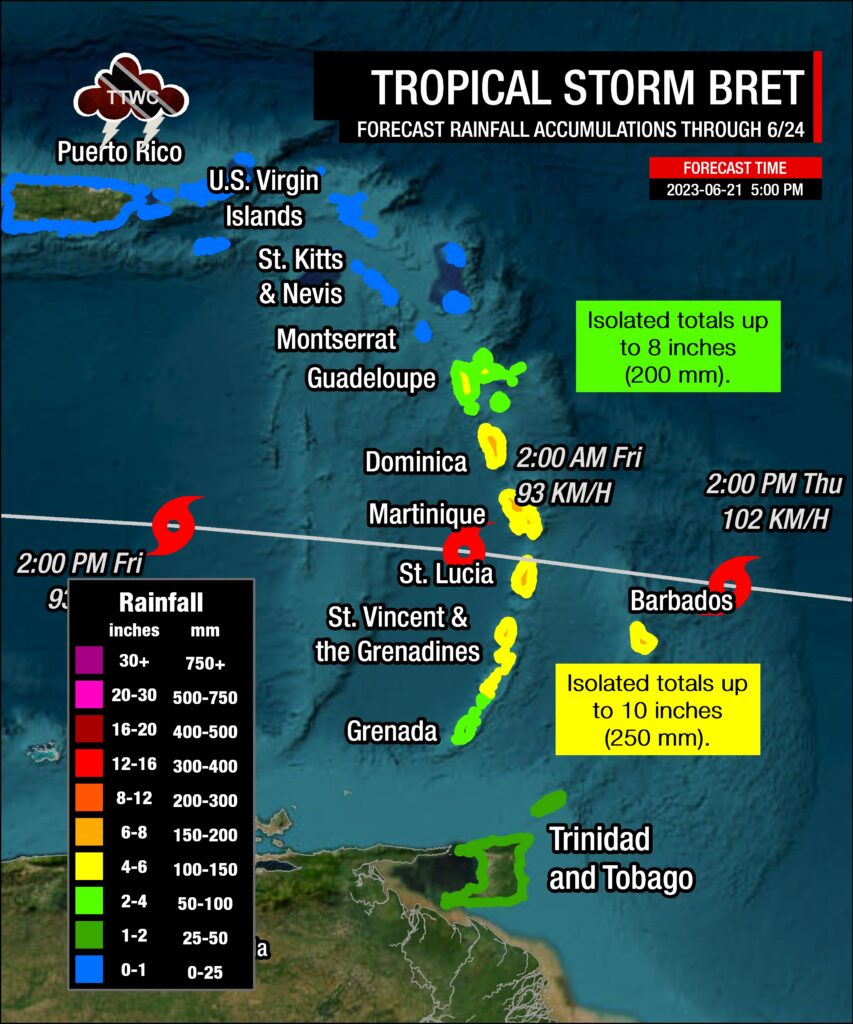Air Force Hurricane Hunters found Tropical Storm Bret marginally stronger on Wednesday afternoon, but significant strengthening remains unlikely over the next 24 hours as it nears the central Lesser Antilles.
While Tropical Storm Bret poses no direct threat to Trinidad and Tobago at this time, a breakdown of the pressure gradient across T&T will lead to warm temperatures and light to near-calm winds on Thursday
Rainfall-wise, isolated showers and thunderstorms associated with localized climatic effects, as well as outer bands and influenced convergence from Bret, are forecast from early Thursday morning through Friday night across and near the country. Where these possible feeder bands develop is difficult to forecast, but models keep the heaviest rains offshore north and east of T&T on Thursday and Friday.
What you need to know
— What has changed: Bret has strengthened with sustained winds up to 100 KM/H and higher gusts to 120 KM/H, with the tropical-storm-force wind diameter increasing to 165 KM, mainly north of the center. This indicates nearly a double in tropical-storm-force wind field in the last 18 hours. Bret has slowed somewhat down to 24 KM/H.
— Where is it forecast to move: Forecast confidence is high with the center of circulation moving across the central Lesser Antilles near St. Lucia and Martinique, well north of Trinidad and Tobago.
— The Intensity & Impacts: The current forecast track places islands northward of St. Vincent and Barbados and southward of Dominica at the highest risk for damaging winds, flooding rainfall, storm surge, and hazardous seas. The National Hurricane Center’s forecast calls for a tropical storm with sustained winds up to 100 KM/H and gusts to 120 KM/H moving across the central Lesser Antilles. For the southern Windwards, southward of St. Vincent and the Grenadines, as well as Barbados to Trinidad and Tobago, feeder bands could extend southward, bringing showers/thunderstorms and gusty winds. In addition, light to near-calm winds will lead to increased daytime temperatures, localized, slow-moving afternoon showers and thunderstorms, and agitated seas mainly on Thursday, with increased winds from the southeast on Friday.
— Latest from officials: A Tropical Storm Warning is now in effect for St. Lucia and Martinique. Tropical Storm Watches are in effect for Barbados, Dominica, and now St. Vincent and the Grenadines with additional watches or upgrades to warnings likely tonight.
The latest

At 5:00 PM Wednesday, June 21st, 2023, Tropical Storm Bret’s approximate center of circulation was located at 13.3°N and 53.9°W, placing the center approximately 605 kilometers east of Barbados.
According to the National Hurricane Center’s 5:00 AM Advisory, Tropical Storm Bret is moving west at 24 KM/H, and this is forecast to continue for the next several days, approaching the Lesser Antilles by late Thursday into the night with an increase in forward speed expected. Bret is forecast to move westward across the eastern and central Caribbean Sea on Friday and Saturday.
Maximum sustained winds have increased to 100 KM/H with gusts to 120 KM/H, with little change in strength before this system reaches the Lesser Antilles. The NHC says this system is forecast to remain a tropical storm as it moves across the Lesser Antilles, with weakening forecast thereafter from Thursday night in the Caribbean Sea, likely dissipating by Saturday. The current minimum central pressure is 1000 millibars, with tropical storm-force winds extending outwards up to 165 kilometers from the center. NOAA Buoy recently reported sustained winds of 68 KM/H and a gust to 79 KM/H.

Current Watches & Warnings

A tropical storm warning is now in effect for St. Lucia and Martinique. A Tropical Storm Warning means that tropical storm conditions are expected somewhere within the warning area within 36 hours.
A tropical storm watch remains in effect for Barbados and Dominica, with one issued for St. Vincent and the Grenadines. A Tropical Storm Watch means that tropical storm conditions are possible within the watch area, generally within 48 hours.
Interests elsewhere in the Lesser Antilles should monitor the progress of Bret. Additional tropical storm watches or warnings will likely be issued tonight.
There are no alerts, watches, or warnings in effect for Trinidad and Tobago at this time from the Trinidad and Tobago Meteorological Service.
What could be the impacts?

For Barbados and the central Lesser Antilles, tropical-storm conditions are possible on Thursday with sustained winds up to 100 KM/H, which can produce wind damage across the islands. Seas are forecast to become hazardous, with forecast rainfall totals likely to produce street/flash flooding and landslides.
South of St. Vincent, southward to Tobago (and to a lesser extent Trinidad), and north of Guadeloupe, feeder bands could produce periods of heavy rainfall and gusty winds which would be capable of producing localized wind damage, street/flash flooding, and locally rough/choppy seas.
For the Leewards, as a result of an increased pressure gradient, elevated winds and hazardous seas are forecast to affect islands north and west of Montserrat and Antigua and Barbuda from Thursday afternoon through Friday night.
For the remainder of the westernmost Greater Antilles, little to no major impacts are forecast.
Wind
As mentioned above, the National Hurricane Center is forecasting, as of 5:00 PM Wednesday, June 21st, 2023, a tropical storm with sustained winds up to 100 KM/H and gusts to 120 KM/H moving across the French Antilles, mainly between St. Vincent and Dominica.
Certainty has increased in both track and intensity, with nearly all intensity models, in line with the National Hurricane Center’s forecast, showing a tropical storm at the time of Bret’s passage across the Lesser Antilles.
With weaker tropical cyclones, the stronger winds generally remain on the northern half of the system’s circulation, meaning St. Lucia, Martinique, Dominica, and even Guadeloupe, could see winds of tropical storm strength.

With feeder bands forecast to traverse much of the eastern Caribbean over the next 24-48 hours, the National Hurricane Center has much of the eastern Caribbean area, north of Trinidad and Tobago, under a low to medium probability of experiencing tropical storm-force winds, but higher probabilities now exist for the central countries of the island chain.
While the southern Windwards aren’t in the direct line of fire from Tropical Storm Bret at this time, outer bands from the tropical cyclone could still have strong showers and thunderstorms that produce tropical-storm-force wind gusts or sustained winds for brief moments – hence the risk is not zero.
Global models show higher winds remaining north of the southern Windward Islands, including Trinidad and Tobago. When strong low-pressure systems (strong tropical waves, tropical storms, or even hurricanes) move sufficiently north of T&T, the winds across Trinidad and Tobago become light to near-calm as the pressure gradient across the area slackens. By Friday, across Trinidad and Tobago, winds are forecast to increase from the southeast, with faster-moving showers and thunderstorms forecast.
Rainfall

The highest rainfall accumulations are forecast to occur across Barbados, St. Vincent and the Grenadines, St. Lucia, Martinique, and Dominica, with rainfall totals through Saturday, June 24th, 2023 ranging between 75 and 150 millimeters (3-6 inches) with isolated totals up to 250 millimeters (10 inches).
For Guadeloupe, rainfall totals have decreased somewhat, with storm rainfall totals forecast between 50 and 100 millimeters (2-4 inches) and isolated totals up to 200 millimeters (8 inches), favoring windward-facing coastlines.
For Grenada, storm rainfall totals are forecast between 50 and 100 millimeters (2-4 inches) and isolated totals up to 150 millimeters (6 inches), favoring windward-facing coastlines.
Isolated higher amounts are possible, but the fast-moving nature of Bret is forecast to limit persisting heavy rainfall and higher accumulations.
For Trinidad and Tobago, rainfall accumulations have trended downward, but generally, T&T could see anywhere from 15 to 25 millimeters of rain, with totals trending towards 50 millimeters across Tobago, eastern Trinidad, and areas where persisting or heavy showers and thunderstorms development.
As mentioned above, feeder bands, convergence associated with Bret, and local topography could produce locally heavy rainfall totals that may trigger localized flooding and mudslides/landslides. Ultimately, all islands across the Lesser Antilles should remain on guard for some form of flooding rainfall associated with this tropical cyclone later this week, whether there is a direct impact or not.
Seas and Storm Surge

Similar to the rainfall totals, how agitated seas become and the level of storm surge is dependent on the strength of the tropical cyclone.
Forecast models are showing waves in open waters are forecast to exceed 2.5 meters (8 feet) and up to 3.5 meters (12 feet) near east-facing coastlines. For areas near the center, waves can reach as high as 4.5 meters (15 feet) near coastlines and up to 6.5 meters (21 feet) in open waters. These higher seas are forecast to remain well north of Trinidad and Tobago, with hazardous seas likely from St. Vincent and the Grenadines, as well as Barbados northward.
For Trinidad and Tobago
Latest Forecast
Tropical Storm Bret, With No Direct or Significant Impacts, Forecast To Influence T&T’s Weather
Trinidad and Tobago is NOT under any tropical storm or hurricane threat, watch, or warning at this time.
In nearly all forecast model guidance as of 5:00 PM Wednesday, June 21st, 2023, Bret’s center of circulation moves well north of Trinidad and Tobago.
As the system nears on Wednesday night into Thursday, convergence ahead of the tropical cyclone, with winds coming from the northeast to north, moves some of the outer bands across the southern Windwards and Trinidad and Tobago. Then, on Thursday, as the center tracks north of Barbados, showers and thunderstorms move across Trinidad, Tobago, and the southern Windwards from the south to the north, feeding into the circulation (feeder bands and localized climatic effects). By Friday into Saturday, southerly to southeasterly wind flow feeds into the tropical cyclone with showers and thunderstorms trailing, moving across Trinidad, Tobago, and the Windwards again.
On Thursday, due to slack to near-calm winds, localized climatic effects like daytime heating, sea breeze convergence, and orographic effects take over, producing slow-moving showers and thunderstorms that are enhanced by topography. These effects can trigger locally heavy rainfall, producing street/flash flooding, gusty winds, and other hazardous weather impacts in localized areas while most of the region experience sweltering temperatures.
Pay close attention to official forecasts in the coming days from your respective authorities. For Trinidad and Tobago, official forecasts and early warnings come from the Trinidad and Tobago Meteorological Service.










